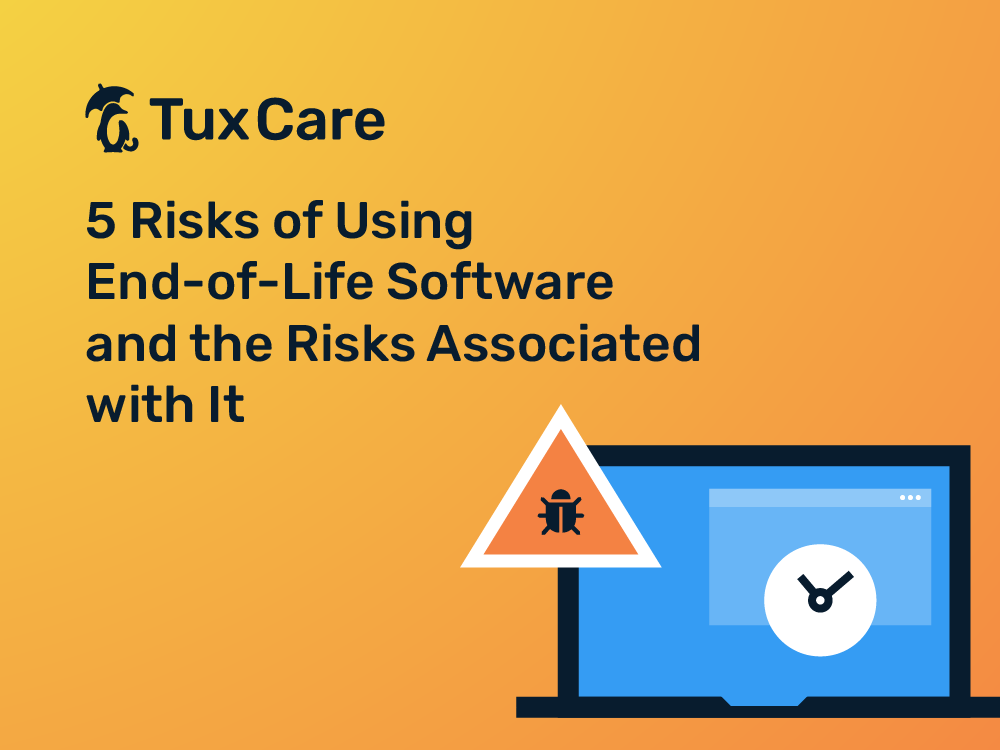5 Risks of Using End-of-Life Software and the Risks Associated with It
End-of-life (EOL) software can pose serious security risks. In this post, we’ll be exploring the dangers of using EOL software, including specific risks for Linux operating systems, the importance of security patches, and how they can help avoid possible security breaches.
Here are the top five risks you need to be aware of.
Vendors Don’t Patch EOL Software
One of the biggest risks of using EOL software is the lack of security updates. Without these updates, a system is exposed to potential security breaches, leaving sensitive data and information at great risk.
Malicious actors are constantly looking for vulnerabilities in software, and once they find one, they can exploit it to gain access to your system, extracting prized information/data and using it as ransom.
Since EOL software no longer receives security updates from the original vendor, hackers can – and still do – easily target these systems and find vulnerabilities to exploit.
Compatibilities Issues
Another risk of using EOL software is that it may not be compatible with other software or hardware features that you use. This, in turn, can result in compatibility issues, causing system crashes, disruptions, and other troubles.
For instance, if you are using an EOL operating system, it may not be compatible with the latest version of a software program you need to use, and this would affect an organization and its employee’s functionality, as well as productivity.
Using EOL software can also limit the organization’s ability to take advantage of new technology and features. Moreover, since new technology and software features are developed regularly, they are also designed to work with the latest software instead of EOL operating systems (OS). If an organization is using end-of-life software, it wouldn’t be able to make the most of new features, setting the company back in terms of productivity and innovation.
So, using EOL software can be a significant risk to an organization’s system and its security. It’s essential to keep software up to date with the latest security patches and updates to avoid potential security breaches.
Reduced Security Updates
The Cybersecurity and Infrastructure Security Agency, CISA, warns that using end-of-life software can create security risks, as software vendors will no longer provide security patches and updates to fix newly discovered vulnerabilities.
This essentially means that any security issues discovered after the end-of-life date will not be resolved, which would leave systems vulnerable to malicious threats. Since hackers often target EOL software, as they know that many users may continue to use it despite the risks, CISA is encouraging organizations to migrate from whatever end-of-life systems they may still be using.
Compliance Issues for Organizations
In addition to security risks, CISA also warns that using EOL software can create compliance issues for organizations. There are regulations in place for companies that require them to maintain secure and up-to-date software and protect sensitive or prized information from being exposed.
Using software that is beyond its end-of-life date may not meet these requirements, leading to potential violations and legal issues. To mitigate these risks, CISA is advising organizations to develop, implement, and utilize a much more robust software than the EOL ones that they are migrating from.
By doing so, organizations can ensure that they are using the latest, most secure software and can avoid the security risks and challenges that come with using EOL software.
Increased Costs
Using end-of-life (EOL) software can increase costs for organizations due to a lack of support from software vendors or when vendors no longer provide security patches, bug fixes, or updates. This leaves organizations vulnerable to security risks – which can be costly to clean up after.
Moreover, since technical support for software that has reached its end-of-life date is often no longer available either, it can be incredibly challenging to resolve issues. So, organizations may need to allocate extra resources to maintain as well as secure end-of-life software. This, in turn, increases costs associated with managing the software (hiring additional IT staff or purchasing a supported software version.)
EOL software may also require specialized skills and knowledge, which, again, results in additional costs. This can seem quite daunting, because there is no one-size-fits-all list, and costs can become never ending.
Moreover, EOL software can also have compatibility issues with newer hardware or software, which can increases downtime and lead to revenue loss.
Overall, the costs associated with using EOL software can quickly add up. So, organizations should opt for software that is up to date and supported, which will eventually minimize security risks and avoid other unnecessary costs.
However, for a variety of reasons, companies may need to use a Linux distribution beyond its end-of-life date. Fortunately, there’s a way to use these systems safely.
Finding a Solution
While the risks associated with using Linux distributions past their end-of-life date are quite daunting, there is a solution ready. Has your organization still not migrated from CentOS-8? TuxCare’s Extended Lifecycle Support provides ongoing security patches and updates for EOL software, just like this version of CentOS.
Extended Lifecycle Support enables organizations to continue using the software with peace of mind, all while minimizing the risk of security breaches and reducing the typical downtime that comes with EOL software.
End-of-life software doesn’t need to put your organization at risk. Speak to a TuxCare cybersecurity expert today to learn about how your organizations can stay up to date and secure while also saving costs.



 Documentation
Documentation Login
Login



